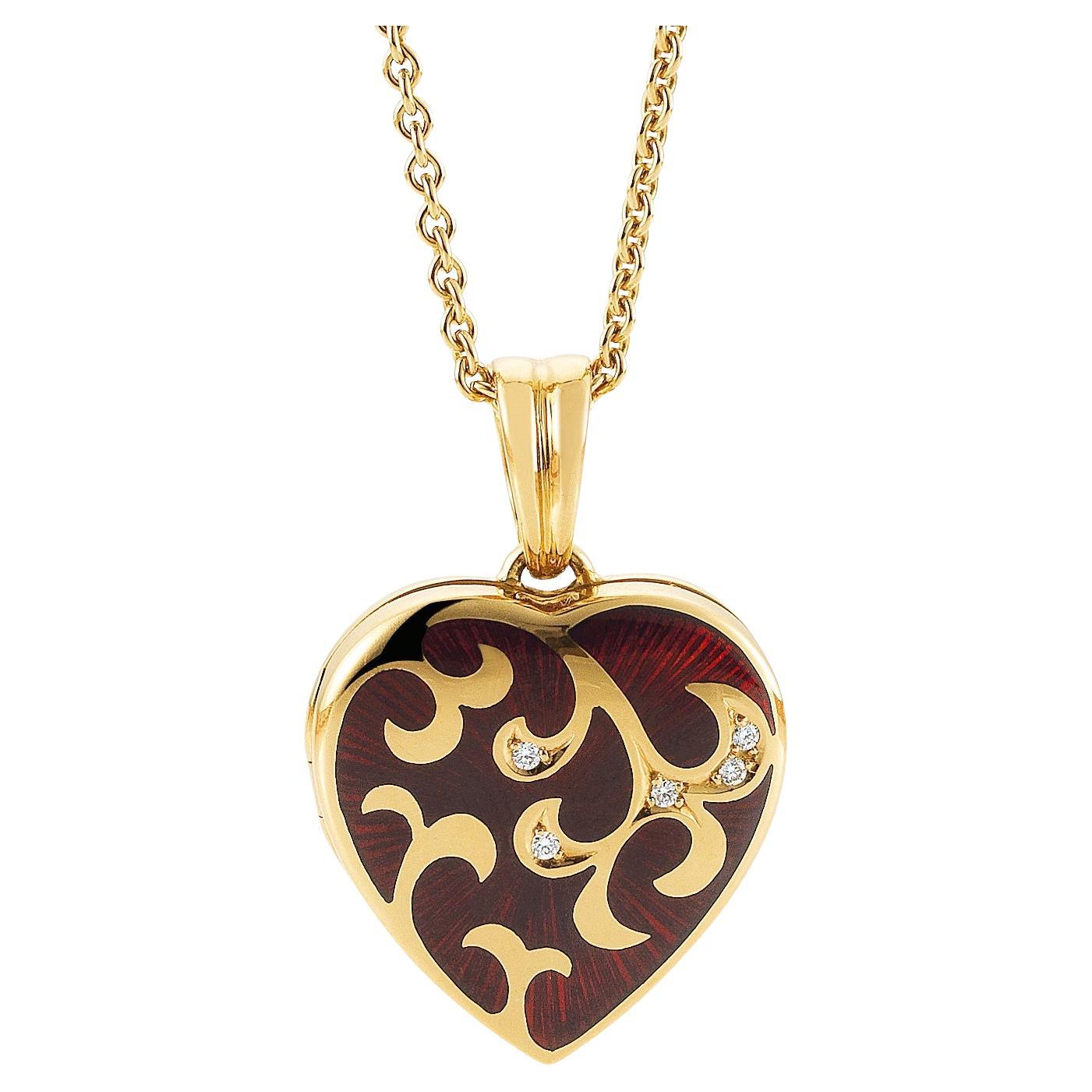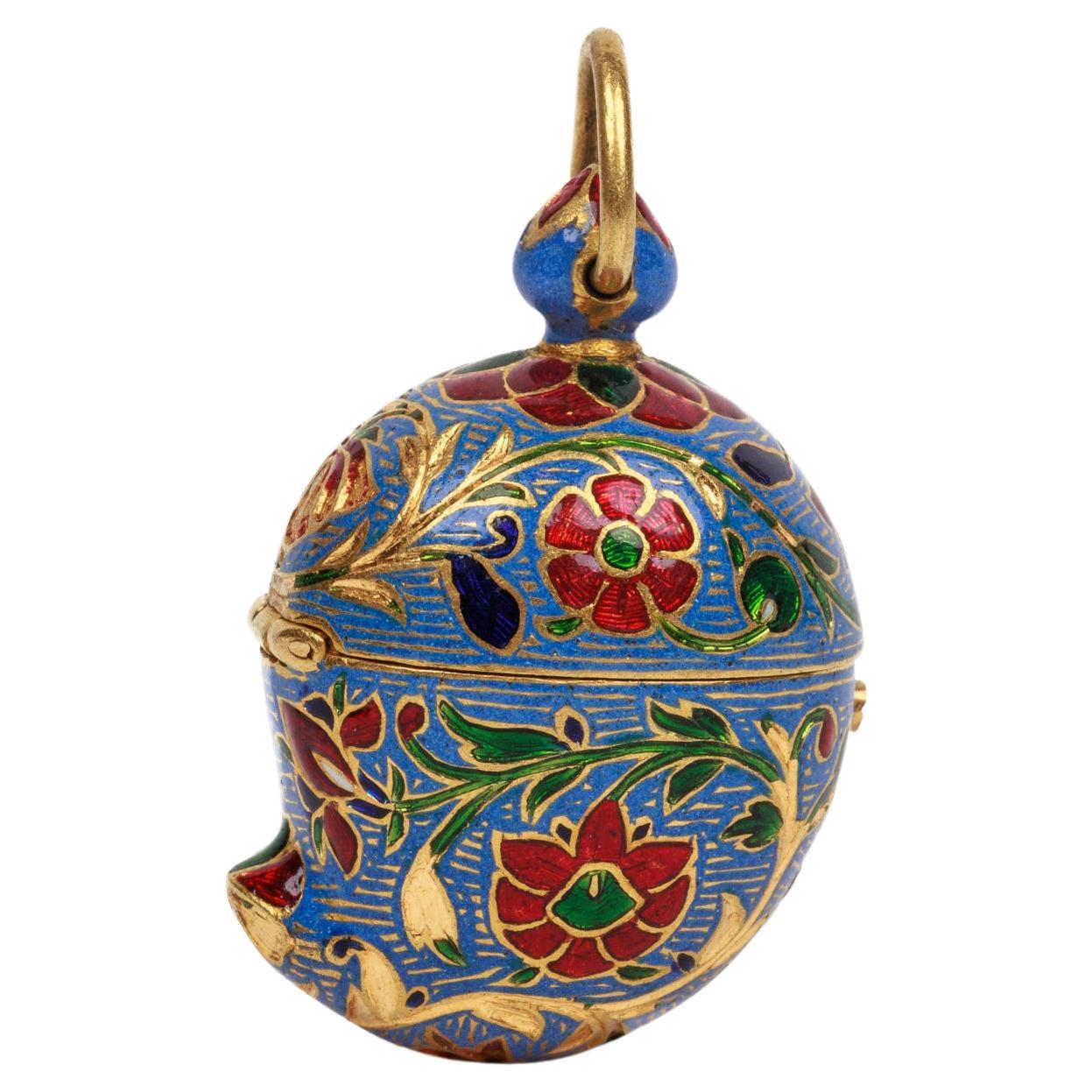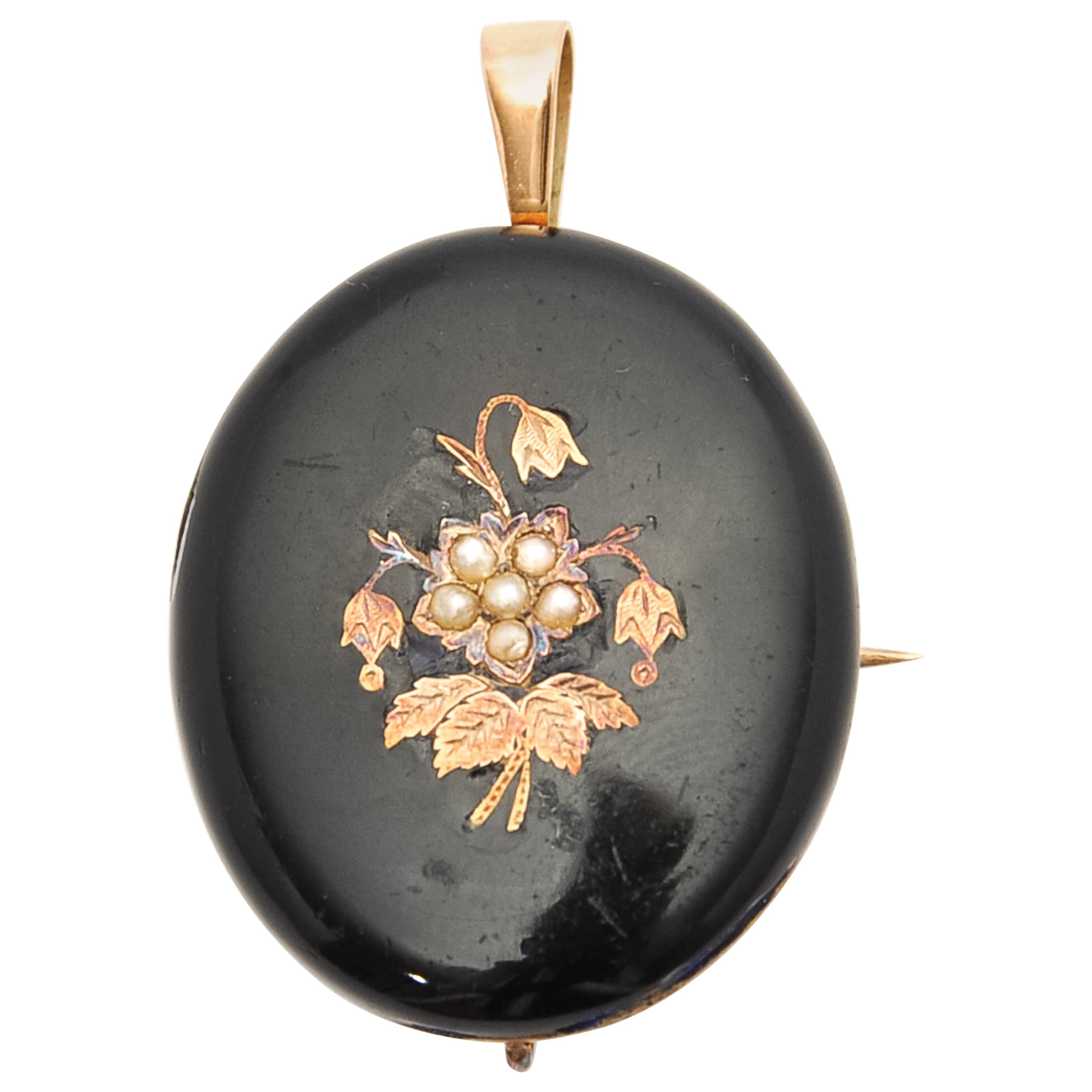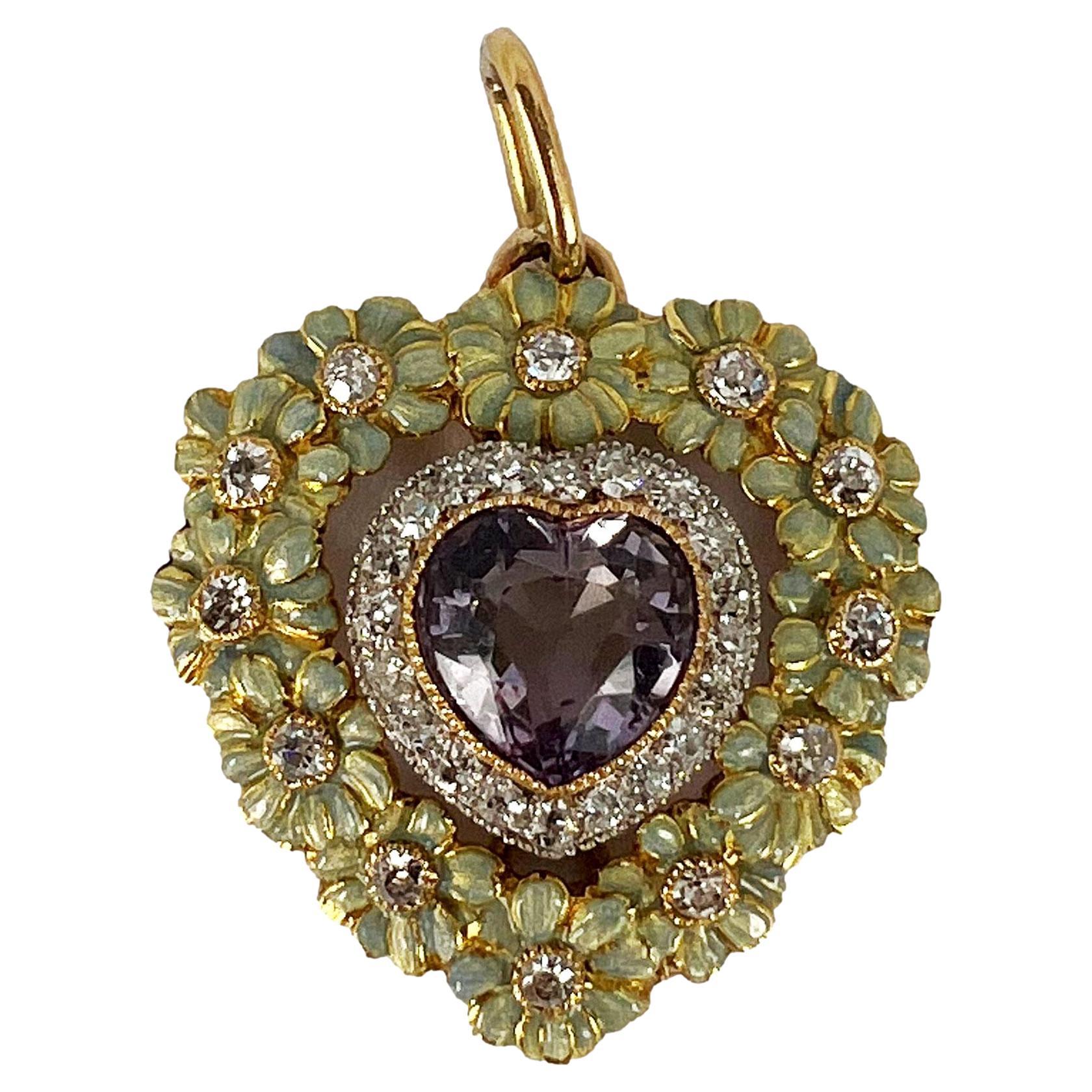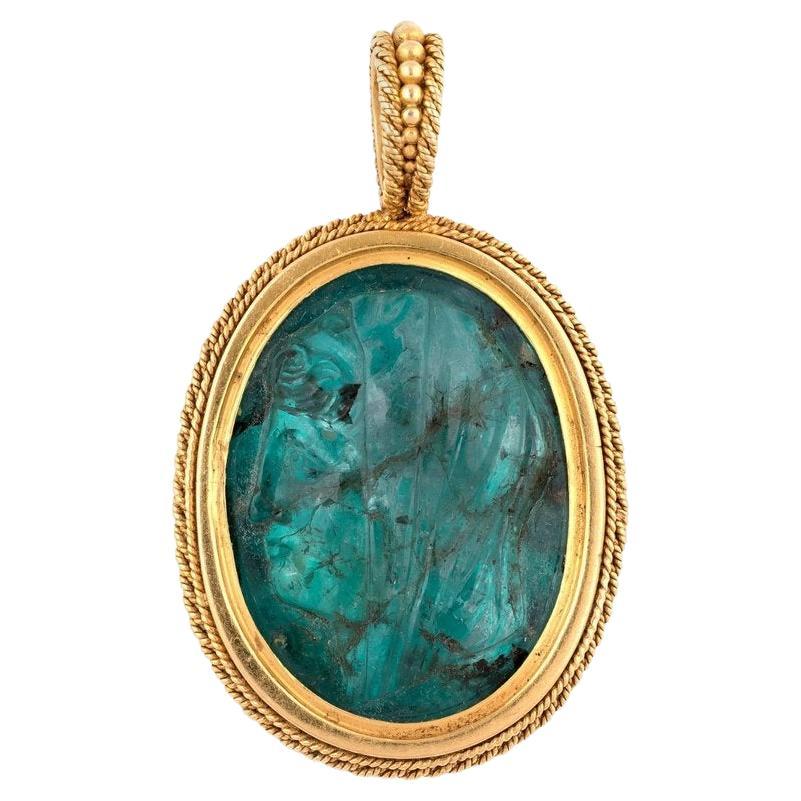Items Similar to Enameled Heart-Shaped Pendant with Cherub & Seed Pearls by Carlo Giuliano c.1880
Video Loading
Want more images or videos?
Request additional images or videos from the seller
1 of 7
Enameled Heart-Shaped Pendant with Cherub & Seed Pearls by Carlo Giuliano c.1880
About the Item
Carlo Giuliano
HEART-SHAPED PENDANT WITH CHERUB
England (London), c. 1880
Gold, enamel, seed pearls
Weight 8.6 gr.; Height 33.3 (42.1 with loop) mm; Width 30.8 mm;
Of all the Revivalist jewelers, the versatile Carlo Giuliano may be the most difficult to recognize without recourse to his maker’s mark. Self-described as an “art jeweler,” Giuliano probably began his training with Castellani in Rome, which inspired his interest in “archaeological-style” jewels. However, he rapidly developed as an independent artist, employing gemstones in unusual ways, incorporating enamel, using silver and gold, and he was evidently receptive to many different styles – Gothic, Renaissance, even Mughal. This enchanting small-scale, enameled pendant, depicting a cherub in a heart-shaped setting, is a case in point.
Brilliant translucent red enamel sets off the pale blue wings that symmetrically frame the face with downcast eyes of the cherub. Feathery wings and curly hair are skillfully brushed with golden highlights best appreciated under magnification. Whereas emamels by Meyer and Grandhomme imitated subjects of the Renaissance (cat. no. 15), this cherub could never be mistaken for a Renaissance work. Instead, it calls to mind the Pre-Raphaelites, who frequented Giuliano, whose sitters sometimes wore his jewels, and who occasionally supplied designs to the “art jeweler.” The vivid color, lush imagery, and sensuous allure of the Pre-Raphaelites is conveyed in this small jewel. Similar cherubs appear in stained glass by Sir Edward Burne-Jones (1833-1898) and in a drawing by Dante Gabriel Rosetti (d. 1882)
Collaborating with Giuliano, Burne-Jones was especially important as a designer of jewelry; cherubs and hearts, often in the Byzantine style, occur in designs now in the Morgan Library and Museum that he made for jewels. These jewels were often highly personal mementos. With its glass lid on the reverse meant to hold a keepsake, the present heart-shaped pendant was perhaps intended as a gift for a member of the Pre-Raphaelite circle.
Description:
Heart-shaped gold pendant with enamel depicts a winged cherub’s head in frontal view against a translucent red background. The hair is golden and the wings pale blue with gilt highlights. The frame has two borders, white with black dots and a meander-like frieze in white on dark blue; thirteen seed pearls on studs adorn the rim. The pendant loop in white with black dots is suspended from a white fleurs-de-lis with foliate ornament in blue. On the reverse is a glass lid (loose in the mount).
Below the pendant loop is a plaque with the maker’s mark “CG.”
Literature:
compare for similar opaque white enamels with fine blue or black markings, Phillips 2019, p. 96 (pendant in the Victoria and Albert Museum); Falk 2004, p. 53, fig. 54, and Gere/Munn 1989, pp. 68–69 (a pendant and necklace respectively); Munn 1975, p. 162, pls. 8a/b (a pendant and earrings with cherubs by Giuliano); for Burne-Jones drawings and Giuliano, Gere/Munn, pp. 139–141.
- Creator:
- Metal:
- Stone:
- Stone Cut:
- Weight:8.6 g
- Dimensions:Height: 1.32 in (33.3 mm)Width: 1.22 in (30.8 mm)
- Style:
- Place of Origin:
- Period:
- Date of Manufacture:1880
- Condition:Wear consistent with age and use.
- Seller Location:Chicago, IL
- Reference Number:
About the Seller
5.0
Vetted Seller
These experienced sellers undergo a comprehensive evaluation by our team of in-house experts.
Established in 1991
1stDibs seller since 2021
5 sales on 1stDibs
Typical response time: 16 hours
- ShippingRetrieving quote...Ships From: Chicago, IL
- Return PolicyA return for this item may be initiated within 3 days of delivery.
More From This SellerView All
- Renaissance Reliquary Pendant with Pearl and EnamelingLocated in Chicago, ILRELIQUARY PENDANT WITH PEARL Spain or Spanish Netherlands, c. 1620 Gold, rock crystal, enamel, pearl, bone relics Weight 12.9 grams; dimensions 40 ...Category
Antique 1620s Spanish Renaissance Pendant Necklaces
MaterialsPearl, Gold, Enamel
- Renaissance Revival Chrysolite Enameled Necklace by GiulianoBy Carlo and Arthur GiulianoLocated in Chicago, ILCarlo and Arthur Giuliano Renaissance Style Chrysolite Enameled Necklace with original box England (London), c. 1895 Gold, enamel, chrysolite Weight 21.4 gr.; Chain 39.8 cm. Gold necklace with red translucent enamel. The centerpiece is formed of three elaborate scrollwork elements, each framing three, fanned out chrysolites in open settings. These are connected by double chains of stylized floral links in red enamel, and the same links create the three pendants in tapering lengths with pear-drop chrysolites, suspended from the central element, as also the chain around the neck with s-shaped hook fastening. On the hook clasp is the maker’s mark “C&AG.” Original fitted brown leather case, gilt triple frame, inset with cream colored velvet and on the matching silk lining of the lid is in gold imprint: A crown, C & A Giuliano/ 115, Piccadilly/London. Self-described as an “art jeweler,” Giuliano began his career on Frith Street in London in 1860. Without a retail shop of his own, he initially supplied jewels to other London firms – Robert Phillip, C. F. Hancock, and Hunt and Roskell...Category
Antique 1890s English Renaissance Revival Drop Necklaces
MaterialsGold, Enamel
- Antique Gold Pendant with Diamonds and PearlsLocated in Chicago, ILPendant with Virgin Mary as Queen of Heaven Western Europe, Southern Germany (?), Italy (?), c. 1550-1560 Gold, enamel, diamonds, and pearls Weight 13.2 gr; Length 36.9 x 31.2 mm (incl. pearls) This sumptuous image exudes regal power. It portrays the Virgin Mary as Queen of Heaven wearing a dress and crown studded with seven large diamonds and set against a translucent, rich blue celestial background. Far removed from the tender, humble Virgin seen in German and Netherlandish artworks of the period, she is a majestic ruler, mouth sternly set, head tilted upward, and face in full profile. The oval pendant cast in high gold relief with a central medallion, the single figure filling the space, echoes jewelry portraits of the aristocracy during the Renaissance, which similarly offset the ruler’s image against a blue field composed of enamel or lapis lazuli, symbolic of divine power Only the rays of the shining gold halo that emerge behind the Virgin’s head and her long flowing hair (instead of neatly coiffed) distinguish her from female ruler portraits of the period. Three studded pearls, forming an axis, also recall pendants of European rulers. Wealth, royal status, and divine power come together in this opulent pendant. Portraits of the period show similar small oval pendants worn by women in the square of the garment or by men nestled inside multiple chains below the base of the neck. PROVENANCE European Private Collection LITERATURE Compare images from ancient Rome, for example a sardonyx cameo with female head (Kugel 2000, no. 18; Milan, c. 1550), and a pendant with gold, pearls, and enamel in the Staatliche Museum Kassel (Schmidberger/Richter 2001, no. 43; France, c. 1555-1560). For ruler pendants with blue backgrounds see a pendant of King Frances I...Category
Antique 16th Century Pendant Necklaces
MaterialsDiamond, Pearl, Gold
- Georgian Ring as a Token of Love with Seed Pearls and Rose GoldLocated in Chicago, ILRING AS TOKEN OF LOVE England or America, about 1800-1820 Rose gold, pearls Weight 3 gr.; circumference: 56.45 mm.; US size 7.75; UK size P 1/2 The expression of love and friendship is universal in life as in death, and hair mementoes...Category
Antique Early 19th Century English Georgian Cocktail Rings
MaterialsPearl, Rose Gold
- Antique Spanish Jet Amulet Pendant with FigaLocated in Chicago, ILAMULET PENDANT WITH FIGA Spain, c. 1620–1630 Jet, silver, and enamel Weight 60.7 grams; dimensions 85 × 49 × 18 mm Large pendant in the shape of a hand carved from jet with a clinched fist in the figa (Spanish higa) gesture. In the palm of the hand is a heart carved in relief and on the back a six-ray star in a circle. The silver mount covers the wrist like a cuff and is decorated with a frilled border, and on the front with collet-set bosses with silver C-scrolls against blue enamel; on the back is a roundel in relief with floral motif. Domed base for the pendant loop in pea-pod form. The figa (also fica or higa) represents an age-old symbol of protection against the evil eye and other demonic threats. Its origins were pagan and buried deep in antiquity. Roman examples, such as one found recently in an archeological excavation in London, also make it clear that the protective qualities are based in a sexual symbolism–particularly the power of the phallus. The Roman bone figa/phallus in effect represents the phallus twice; that is, the gesture made by the figa hand is generally explained as fingers representing the female genitalia (vulva) penetrated by the phallus of the thumb. But other interpretations are less specific, including explanations that the left hand is the feminine principle, and the right hand is the masculine. In Spain, jet figa are common; we see one in the portrait of Anne of Austria the infanta (p. 75). That is not to say that the objects are not sumptuous or treasured. Jet was a very valuable material, and in many examples like this one, the figa is embellished with beautiful enameling or is even gem-studded. Comparable objects occur in equally sumptuous materials such as rock crystal. The enameled setting allows a dating of these objects that otherwise might prove difficult, given that the production of such objects in Spain is so consistent over centuries. Indeed, there is another, even more elaborately carved example in this collection, attached to the “magic belt” (no. 9). That example may belong to an earlier group. That figa includes deeply excavated carving, including on the upper surface, an M-shaped design that Walter Leo Hildburgh links to the heart shape (as it occurs more explicitly on this example). Hildburgh argues that its presence is especially common on these objects and that it originally represented the Sacred Heart of Mary...Category
Antique Early 17th Century Spanish Pendant Necklaces
MaterialsSilver
- Antique Silver Spanish Cross Pendant with Rock CrystalsLocated in Chicago, ILCross Pendant with Rock Crystals Spain or Portugal, late 17th - early 18th century Silver, gold, rock crystal Weight 9.1 gr.; Dimensions 56.3 × 38.8 mm. An elaborate and elegant cross pendant made of silver with rock crystals in closed settings. The center consists of a larger round gemstone surrounded by five irregular-shaped stones forming the cross. The openwork arms have a triangular shape and are formed of facetted rock-crystals in foliate settings. The obverse side of the cross consists of a layer of gold. An extension with two stones and an angular shaped frame is hooked into the pendant loop, probably to be worn on a velvet band. The pendant is in good, wearable condition. After the Reformation, cross pendants were worn mainly in Catholic countries by men, women, and children. During the seventeenth century, the designs became ever more intricate, and the crosses were often embellished with gemstones, such as rock crystals in this example. These were sourced along the Alpine regions of France, Switzerland, Austria, and Southern Germany. The stones gave the appearance of diamonds. The foliate settings are characteristic of late seventeenth- and eighteenth-century jewelry made in Spain...Category
Antique Late 17th Century Pendant Necklaces
MaterialsCrystal, Rock Crystal, Gold, Gold Plate, Silver
You May Also Like
- Heart Shaped Locket Pendant 18k Yellow Gold Red Enamel 5 Diamonds 0.05ct H VSBy Victor MayerLocated in Pforzheim, DEHeart shaped locket pendant, Hallmark Collection by VICTOR MAYER, 18k yellow gold, red vitreous enamel, 5 diamonds, total 0.05 ct, H VS, brilliant cut About the creator Victor Maye...Category
21st Century and Contemporary German Baroque Revival Pendant Necklaces
MaterialsDiamond, 18k Gold, Yellow Gold, Enamel
- 22K Indian Gold and Enamel Mango Shaped PendantLocated in New York, NYA 22K Indian Gold and Enamel Mango Shaped Pendant, Jaipur, 19th Century. Finley enameled with green, red, and blue enamel throughout, decorated with f...Category
Antique 19th Century Indian Pendant Necklaces
MaterialsGold, Enamel
- Antique Black Onyx Seed Pearl Gold Brooch PendantLocated in Rotterdam, NLAn antique 19th century black onyx pendant created with pearls set in a gold floral decor. The oval-shaped brooch pendant is set with golden leaves and a floral pattern inlaid with six seed pearls in the center. The bail at the top is made in 14 karat gold and can also be worn as a brooch. The Victorians adored using...Category
Antique Late 19th Century Dutch Victorian Pendant Necklaces
MaterialsOnyx, Pearl, Gold, 14k Gold, Yellow Gold
- Antique Victorian Gold and Seed Pearl Cross PendantLocated in Rotterdam, NLAn antique Victorian cross pendant crafted in 14 karat yellow gold created with a chased ornamental decor. The design of the cross is embellished with tendril and leaf motifs from to...Category
Antique Late 19th Century Dutch Victorian Pendant Necklaces
MaterialsPearl, Gold, 14k Gold, Yellow Gold
- Edwardian Morganite Heart Platinum Gold Diamond Enamel PendantLocated in London, GBAn exquisite platinum topped 18 karat (18K) yellow gold heart-shaped pendant centring a heart-shaped pink morganite weighing approximately 1.70 carats in a single-cut diamond surround, further surrounded by 12 blue-green enamelled flowers with diamond...Category
Early 20th Century Unknown Edwardian Pendant Necklaces
MaterialsDiamond, Morganite, Gold, 18k Gold, Yellow Gold, Platinum, Enamel
- Late 16th Century Emerald Cameo Empress Berenice by Carlo GiulianoLocated in Firenze, ITMounted a pendant in 1st half 19th century by Carlo Giuliano On the back engraved the pyramids in Egypt Size of the cameo is 26mm x 20mm The pendant is long 43mm Carlo Giuliano (1831–1895) was a goldsmith and jeweller operating in London from 1860. He started work in Naples for Alessandro Castellani and was sent to London to establish a branch of the Casa Castellani. He left Castellani's employ in the early 1860's and in turn worked for Robert Phillips, Harry Emanuel...Category
Antique Late 19th Century British Victorian Pendant Necklaces
MaterialsEmerald, 18k Gold, Yellow Gold
Recently Viewed
View AllMore Ways To Browse
Antique Glass Cat
Antique Small Pearl Necklace
Loose Pearl
Antique Jewels London
Blue Enamel Pendant Pearls
Antique Seeded Glass
Silver Rimmed Pendant
Antique Golden Necklace
Circle Pearl Necklace
Keepsake Necklace
Victoria Pearl
Necklace With Keepsake
Pearl Circle Earrings
Gold Cherub Pendant
Fleur De Lis Blue
Antique Fleur De Lis Jewelry
Victoria Earrings
Antique Cat Jewelry
